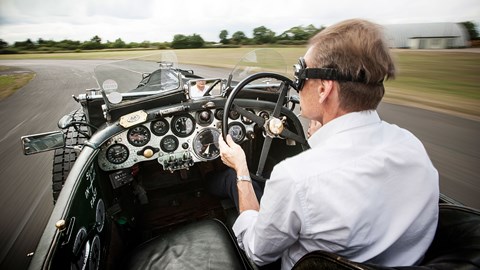► Bentley’s precious Blower
► £15 million Bentley rarity
► Gavin Green pays respect
Behold, the most precious Bentley of them all, worth about £15 million. This car is the most historically important of that most iconic of pre-Bentleys, the Blower (named after its supercharger). In the pantheon of old British transport icons, it’s up there with the Spitfire.
The Blower didn’t win many races and never conquered Le Mans (which its naturally aspirated brothers won five times in the ’20 and ’30s). Rather, the Blower Bentley was famed for its stand-out performance. Bolting a supercharger onto the nose of a 4½-litre Bentley – it literally sticks out from the grille – transformed one of the world’s fastest road cars into a Grand Prix contender. Sir Tim Birkin narrowly failed to win the French GP in 1930 in this very car (he came second). It was almost certainly – at nearly two tonnes – the heaviest car ever to enter a GP. Another modified Blower later lapped Brooklands at 138mph.
The whole driving experience is unlike anything a modern car can dish up. To coax this lumpy old four-cylinder into life involves turning on an electrical master switch, the magnetos, a fuel pump, pressing a brass starter button, then advancing the timing (by a lever) as the beast explodes into life with a gruff roar.
Or take the pedal layout. Where you expect to find the brake pedal, there is a throttle. And where popular prejudice dictates the location of an accelerator, we find a brake. (This transposition of the ‘go’ and ‘stop’ pedals was in fact common in many pre-war cars.)
Bentley Blower: the drive
The steering wheel – Bakelite-rimmed, metal-spoked – is vast in size and astonishingly weighty to manoeuvre. The clutch, conventionally sited to the left, is thigh-bustingly meaty. Changing gear means double-declutching. You have to be precise, firm-but-delicate, and get the revs just-so.
Throttle response, thanks to the supercharger, is mighty and neck-jarringly instant, especially from low revs. The long-stroke engine is slow revving and torquey, like a big diesel. The sweet spot is at about 2600rpm (85mph in top gear) although it will keep bellowing, coarsely, up to 4500.
Cornering involves a mighty stab on that brake pedal (on the right!) and then great arm and shoulder heft, as you manhandle the steering wheel. Enter the corner slow – otherwise the nose-heavy, top-heavy behemoth will plough off the road, snout first. Then accelerate strongly (centre pedal!), the four-pot growling and screaming, as it punches hard for an 86 year-old.
As we drive, there is a delightful cocktail of sensations: a slight whiff of oil and petrol and exhaust fumes; the bellowing exhaust behind and roar of the engine in front; the faint whistle and whine of the supercharger; and wind blasting your face from around the dainty little aero screens.
So behold the most celebrated of all pre-war Bentleys. Just 55 Blowers were built, five of them racing team cars. Ironically poor old WO, Bentley’s founder, didn’t like his masterpiece. He hated forced induction, far preferring the performance of big, naturally aspirated engines.
The anatomy of the Bentley Blower

1) Remember when racing cars had manual lap counters? Thought not. That’s what the little counter on top left of dash is for
2) Blower is full of unfamiliar instruments. Like air-pressure gauges for fuel tank. Clock (top left) including stopwatch had to be manually wound
3) Two little tubes at the bottom of the dash are to show, and adjust, the flow of oil to the big nose- mounted Roots supercharger
4) Brass lever on steering wheel advances and retards ignition timing. Note big tacho (near Green’s left hand) – redlined at 4500rpm
The specs
Produced: 1929-1931:
Price at launch: £1720
Value now: £15 million (Birkin car), £4-6 million (a ‘normal’ Blower)
Engine: 4398cc inline four-cylinder, supercharged, 240bhp (race cars), 221lb ft
Performance: 8.0sec 0-60mph, 125mph